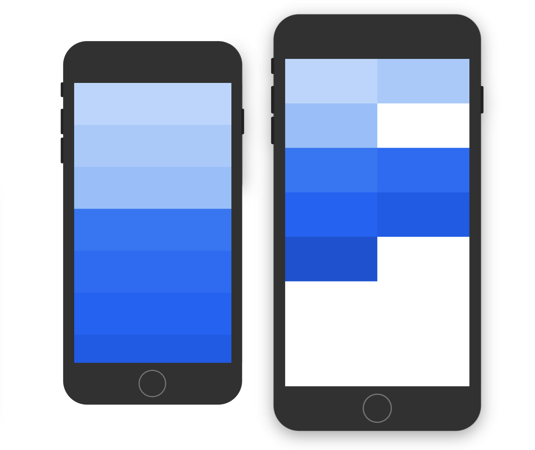

- React native responsive layout how to#
- React native responsive layout install#
- React native responsive layout code#
This makes responsive UI development for RN as simple as using Bootstrap's grid system. RNRL offers the ability to specify different element sizes and styles or even swap entire components depending on target size.

RNRL brings over the good parts from web development in order to simplify native development. However, responsive RN UIs still require the use of many conditional renderings and size-specific overrides. This difficulty was somewhat mitigated when percentage-based widths landed.
React native responsive layout install#
To install the latest version simply run: yarn add react- native-responsive-layoutĪlternatively, if you prefer using npm: npm install -save react- native-responsive-layoutĮven though React Native offers a faster way to build complex native applications, creating responsive RN UIs is significantly more difficult than compared to web development. This package is only compatible with RN >= 0.52 since older versions do not support percentage-based widths AND theĬorrect prop-types for views.

It does not reflect the views or opinions of our editorial team and management.A framework that makes building responsive React Native user interfaces easier by bringing over concepts from web development. This is an article provided by our partners’ network. You can check it here or here to name just a few. That’s why styles which affect the layout on rotation should be placed inline.Īs you might expect, a huge React Native community already provides packages which solve many of the issues mentioned here.
React native responsive layout how to#
We already know how to trigger a rerender of the layout when the device is rotated, but the styles are loaded only once. If you want to take advantage of the orientation in your styles, remember that it should be inline styles. It is fired on every layout change, so it should be used carefully. That’s all! You can also pass getOrientation to onLayout prop exposed by View component. To find out what the screen dimensions are we can use Dimensions API. However, sometimes we have to deal with different layouts for specific screen dimensions or device types.īy default React Native doesn’t provide properties which clearly answer which device or what screen size is. It is great when your designs are the same for both platforms, and all types of devices (mobile, tablets, ipads). If you know only one dimension of your element (width or height), it keeps the second dimension in relation to the one you already know. Aspect RatioĪnother cool prop is aspect ratio (it’s available only in React Native) which helps keep proportions of your elements under control. I touched just a few to show how they can be helpful. FlexDirection and justif圜ontent keep layout behaviour consistent. You can check few possible placements below:Īlign Items - it works the same as justif圜ontent but align items on the perpendicular axis to the main axis.įlex prop do a really good job of keeping proportions between elements. Justif圜ontent - this prop helps you to position content inside a container along the main axis. By default flexDirection is set to a column instead of row - which is caused by the nature of the screen on mobile devices.

In other cases they will split the sum of the flex among themselvesįlex direction - we can pick a row or a column (you can also set the reverse) to set your main axis along which your content will be placed. If all elements have flex: 1 they will have the same width. As mentioned above it’s limited to single numbers. There are few main properties provided by flexbox, so let’s get through them!įlex describes how elements divide space between them. If flex is a negative number it also uses height and width but if there is not enough space it will shrink to its minHeight and minWidth. When flex: 0 - it’s sized accordingly to the height and width and is inflexible. That means that flex equates to flexGrow:, flexShrink: 1, flexBasis: 0. When flex prop is a positive number, then components become flexible and will adjust to the screen respective to its flex value. It’s created to keep the proportions and consistency of the layout on different screen sizes.įlexbox works very similar to CSS on the Web with just a few exceptions which are really easy to learn. First of all, FLEXBOXĬomponents can control layout with a flexbox algorithm. In this short article I’ll try to show you a few tools and tricks which can help you deal with the huge range of devices without going crazy! 1.
React native responsive layout code#
When you code an app with React Native you can add up these numbers and then multiply it by two, since every device can be rotated. Native Apps developers always put a lot of effort into making beautiful apps with a rich UI and which are stable on every supported device. This article was originally published on on Oct. How to Create Responsive Layouts in React Native


 0 kommentar(er)
0 kommentar(er)
